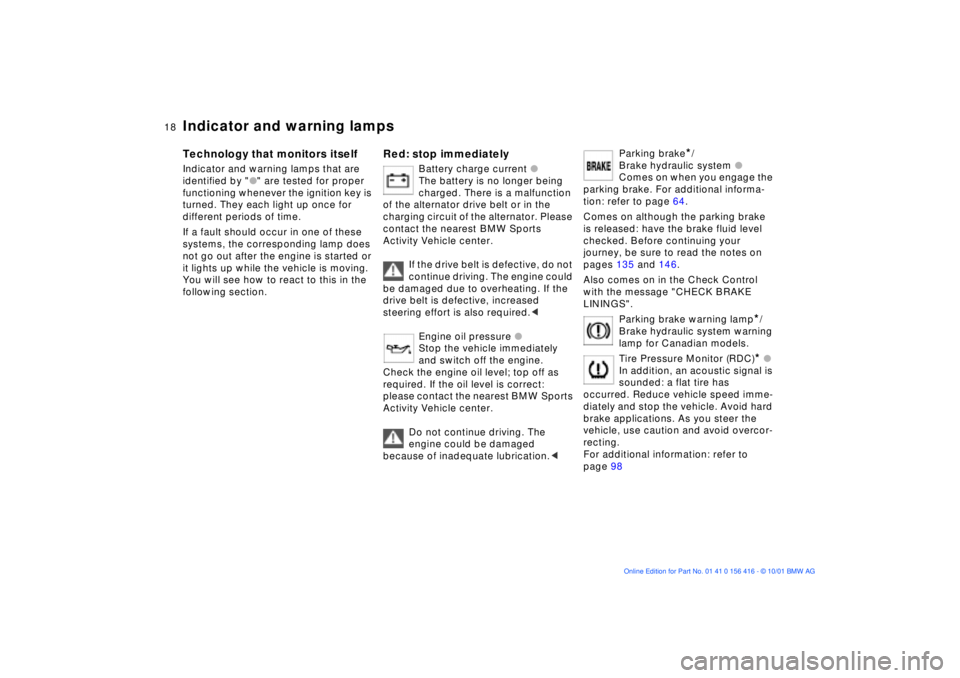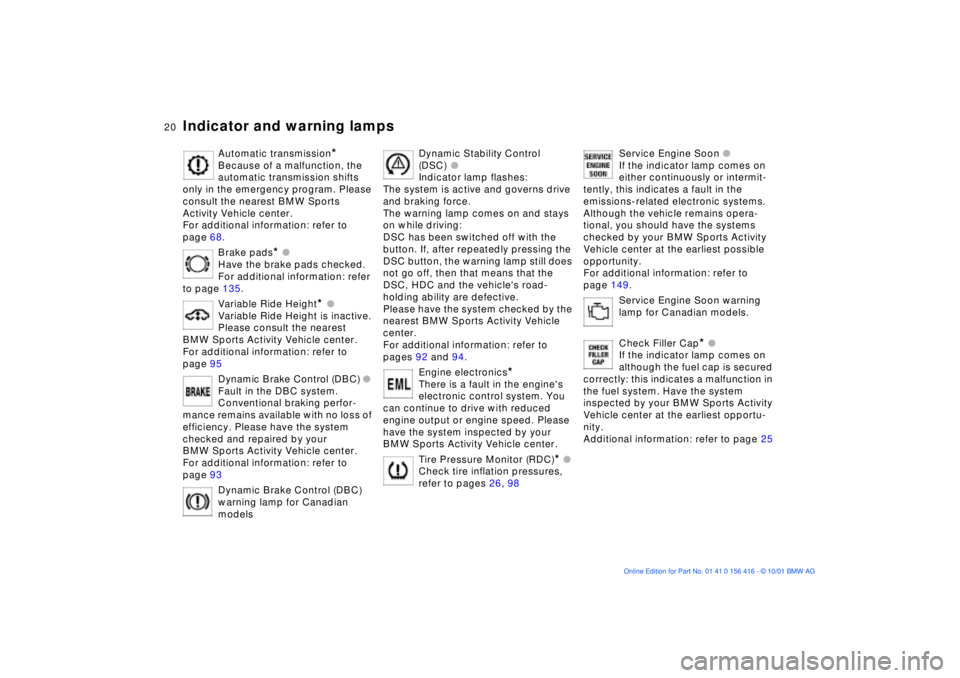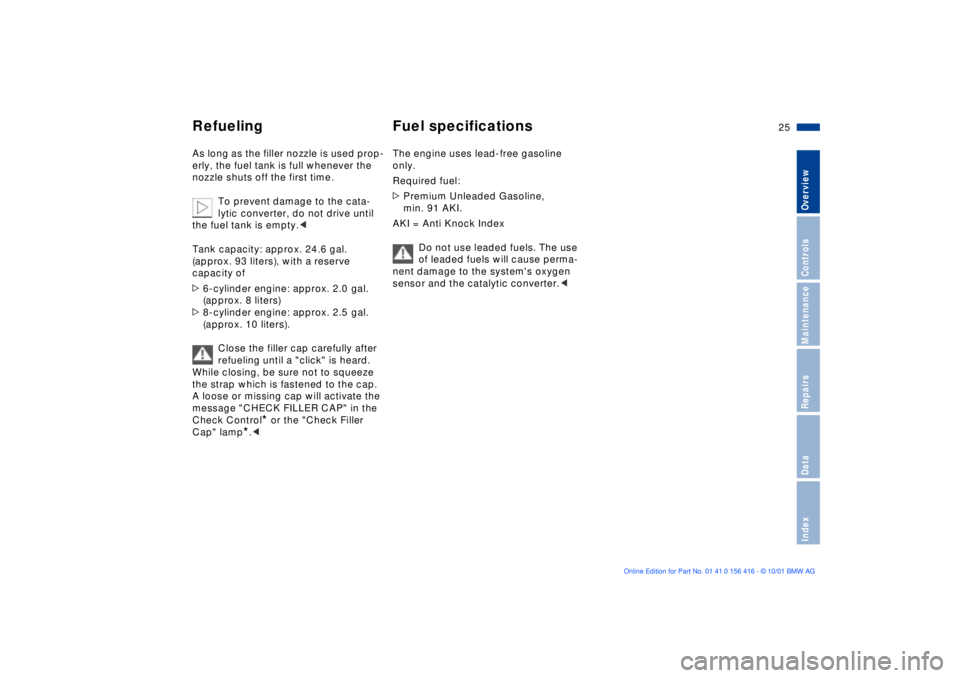engine BMW X5 4.4I 2002 Owners Manual
[x] Cancel search | Manufacturer: BMW, Model Year: 2002, Model line: X5 4.4I, Model: BMW X5 4.4I 2002Pages: 185, PDF Size: 2.7 MB
Page 4 of 185

Contents
© 2001 Bayerische Motoren Werke
Aktiengesellschaft
Munich, Germany
Reprinting, including excerpts, only with the
written consent of BMW AG, Munich.
Order no. 01 41 0 156 416
US English IX/2001
Printed in Germany
Printed on environmentally friendly paper
(bleached without chlorine, suitable for recycling).
Overview
Controls and features
Cockpit14
Instrument cluster15
Indicator and warning lamps18
Steering wheel with multifunction
buttons22
Warning triangle23
First-aid kit23
Refueling24
Fuel specifications25
Tire inflation pressures26
Locks and security systems:
Keys30
Central locking system30
Opening and closing
Ð via the door lock31
Opening and closing
Ð via the remote control32
Opening and closing
Ð from the inside35
Liftgate36
Tailgate37
Alarm system39
Electric power windows40
Sliding/tilt sunroof with glass
moonroof42
Adjustments:
Correct sitting posture44
Seats44
Mechanical seat45
Power seat46
Head restraints47
Power rear-seat backrest
adjustment48
Safety belt49
Seat, mirror and steering wheel
memory50
Seat heating51
Adjusting steering wheel52
Steering wheel heating53
Mirrors53
Passenger safety systems:
Airbags55
Transporting children safely58
Vehicle Memory, Key
Memory61
Driving:
Ignition lock62
Starting the engine62
Switching off the engine64
Parking brake64
Manual transmission65
Automatic transmission with
Steptronic66
Indicator/Headlamp flasher68
Washer/Wiper system/Rain
sensor69
Cruise control71
Everything under control:
Odometer, outside temperature
display74
Tachometer75
Energy control75
Fuel gauge75
Coolant temperature gauge76
Service Interval Display76
Check Control77
Computer80
Multi-Information Display
(MID)82
Digital clock in the MID83
Computer in the MID86
Inhalt
Page 6 of 185

Contents
Operation, maintenance
Owner service procedures
Technical data
Under the hood:
Hood141
Engine compartment
essentials142
Washer fluid143
Engine oil143
Coolant145
Brake fluid146
Care and maintenance:
The BMW Maintenance
System147
Laws and regulations:
Technical modifications148
California Proposition
65 Warning148
OBD interface socket149
Replacement procedures:
Onboard tool kit152
Windshield wiper blades152
Lamps and bulbs153
Changing a wheel156
Battery162
Fuses163
Assistance, giving and
receiving:
Jump-starting164
Towing the vehicle166Engine specifications170
Dimensions171
Weights172
Capacities173
Page 18 of 185

18n
Indicator and warning lamps
Technology that monitors itself
Indicator and warning lamps that are
identified by "
l
" are tested for proper
functioning whenever the ignition key is
turned. They each light up once for
different periods of time.
If a fault should occur in one of these
systems, the corresponding lamp does
not go out after the engine is started or
it lights up while the vehicle is moving.
You will see how to react to this in the
following section.
Red: stop immediately
Battery charge current
l
The battery is no longer being
charged. There is a malfunction
of the alternator drive belt or in the
charging circuit of the alternator. Please
contact the nearest BMW Sports
Activity Vehicle center.
If the drive belt is defective, do not
continue driving. The engine could
be damaged due to overheating. If the
drive belt is defective, increased
steering effort is also required.
<
Engine oil pressure
l
Stop the vehicle immediately
and switch off the engine.
Check the engine oil level; top off as
required. If the oil level is correct:
please contact the nearest BMW Sports
Activity Vehicle center.
Do not continue driving. The
engine could be damaged
because of inadequate lubrication.
<
Parking brake
* /
Brake hydraulic system
l
Comes on when you engage the
parking brake. For additional informa-
tion: refer to page 64.
Comes on although the parking brake
is released: have the brake fluid level
checked. Before continuing your
journey, be sure to read the notes on
pages 135 and 146.
Also comes on in the Check Control
with the message "CHECK BRAKE
LININGS".
Parking brake warning lamp
*
/
Brake hydraulic system warning
lamp for Canadian models.
Tire Pressure Monitor (RDC)
*
l
In addition, an acoustic signal is
sounded: a flat tire has
occurred. Reduce vehicle speed imme-
diately and stop the vehicle. Avoid hard
brake applications. As you steer the
vehicle, use caution and avoid overcor-
recting.
For additional information: refer to
page 98
Page 19 of 185

19n
OverviewControlsMaintenanceRepairsDataIndex
Indicator and warning lamps
Red or yellow: continue to drive;
drive cautiously
If the brake warning lamp
comes on red together with the
yellow warning lamps for ABS
and DSC:
Continue to drive; drive
cautiously and defensively and
avoid full brake applications.
Have the system checked by the
nearest BMW Sports Activity Vehicle
center.
For additional information: refer to
pages 92 and 134.
If all three warning lamps come on
yellow:
Continue to drive; drive cautiously and
defensively and avoid full brake appli-
cations.
Have the system checked by your
BMW Sports Activity Vehicle center as
soon as possible.
Warning lamps for Canadian
models.
Red: an important reminder
Parking brake
*
Comes on when the parking
brake is engaged.
For additional information: refer to
page 64.
Parking brake warning lamp
*
for
Canadian models.
Please fasten safety belts
l
Together with an acoustic signal
or a message
*
in the Check
Control. Comes on until the safety belts
are fastened. For additional information
on safety belts: refer to page 49.
Airbags
l
Please have the system
inspected by your BMW Sports
Activity Vehicle center.
For additional information: refer to
page 55.
Yellow: check as soon as possible
Antilock Brake System (ABS)
l
ABS has been deactivated in
response to system malfunction.
Conventional braking performance
remains available with no loss of effi-
ciency. Please have the system
inspected by your BMW Sports Activity
Vehicle center.
For additional information: refer to
page 134
ABS warning lamp for Canadian
models.
Engine oil level
Comes on while driving:
The oil level is at the absolute
minimum; refill as soon as possible. Do
not drive more than approx. 30 miles
(50 km) until you do.
For additional information: refer to
page 143.
Engine oil level
Comes on after the engine has
been switched off: add engine
oil at your earliest opportunity (when
you stop to refuel).
For additional information: refer to
page 143.
Page 20 of 185

20n
Indicator and warning lamps
Automatic transmission
*
Because of a malfunction, the
automatic transmission shifts
only in the emergency program. Please
consult the nearest BMW Sports
Activity Vehicle center.
For additional information: refer to
page 68.
Brake pads
*
l
Have the brake pads checked.
For additional information: refer
to page 135.
Variable Ride Height
*
l
Variable Ride Height is inactive.
Please consult the nearest
BMW Sports Activity Vehicle center.
For additional information: refer to
page 95
Dynamic Brake Control (DBC)
l
Fault in the DBC system.
Conventional braking perfor-
mance remains available with no loss of
efficiency. Please have the system
checked and repaired by your
BMW Sports Activity Vehicle center.
For additional information: refer to
page 93
Dynamic Brake Control (DBC)
warning lamp for Canadian
models
Dynamic Stability Control
(DSC)
l
Indicator lamp flashes:
The system is active and governs drive
and braking force.
The warning lamp comes on and stays
on while driving:
DSC has been switched off with the
button. If, after repeatedly pressing the
DSC button, the warning lamp still does
not go off, then that means that the
DSC, HDC and the vehicle's road-
holding ability are defective.
Please have the system checked by the
nearest BMW Sports Activity Vehicle
center.
For additional information: refer to
pages 92 and 94.
Engine electronics
*
There is a fault in the engine's
electronic control system. You
can continue to drive with reduced
engine output or engine speed. Please
have the system inspected by your
BMW Sports Activity Vehicle center.
Tire Pressure Monitor (RDC)
*
l
Check tire inflation pressures,
refer to pages 26, 98
Service Engine Soon
l
If the indicator lamp comes on
either continuously or intermit-
tently, this indicates a fault in the
emissions-related electronic systems.
Although the vehicle remains opera-
tional, you should have the systems
checked by your BMW Sports Activity
Vehicle center at the earliest possible
opportunity.
For additional information: refer to
page 149.
Service Engine Soon warning
lamp for Canadian models.
Check Filler Cap
*
l
If the indicator lamp comes on
although the fuel cap is secured
correctly: this indicates a malfunction in
the fuel system. Have the system
inspected by your BMW Sports Activity
Vehicle center at the earliest opportu-
nity.
Additional information: refer to page 25
Page 24 of 185

24n
Refueling Fuel filler door
Before filling the tank, switch off
the engine. If you do not, fuel
cannot be filled into the tank and the
"Service Engine Soon" lamp may come
on.<
To open the fuel filler door, press on the
front edge.
In the event of an electrical malfunction,
you can also open the fuel filler door
manually:
1. Open the cover on the right in the
cargo area: lift the handle on the
cover
2. Pull the knob with the fuel pump
symbol.
530de243
When handling fuels, comply with
all of the applicable safety precau-
tions and regulations pertaining to
fuels. Never carry spare fuel containers
in your vehicle. Whether empty or full,
these containers can leak, cause an
explosion, or lead to fire in the event of
a collision.<
Simple and environmentally
friendly
Open the filler cap carefully to
prevent fuel from spraying out.
Fuel spray may cause injury.
Do not top off. Topping off may cause
fuel spillage.<
Keep the filler cap in the bracket
attached to the fuel filler door.
When refueling, insert the filler nozzle
completely into the filler pipe. Pulling
the nozzle out of the pipe during refu-
eling
>results in premature pump shutoff
>and will reduce the effect of the vapor
recovery system on the pump.
530us008
Page 25 of 185

25n
OverviewControlsMaintenanceRepairsDataIndex
Refueling Fuel specifications As long as the filler nozzle is used prop-
erly, the fuel tank is full whenever the
nozzle shuts off the first time.
To prevent damage to the cata-
lytic converter, do not drive until
the fuel tank is empty.<
Tank capacity: approx. 24.6 gal.
(approx. 93 liters), with a reserve
capacity of
>6-cylinder engine: approx. 2.0 gal.
(approx. 8 liters)
>8-cylinder engine: approx. 2.5 gal.
(approx. 10 liters).
Close the filler cap carefully after
refueling until a "click" is heard.
While closing, be sure not to squeeze
the strap which is fastened to the cap.
A loose or missing cap will activate the
message "CHECK FILLER CAP" in the
Check Control
* or the "Check Filler
Cap" lamp
*.<
The engine uses lead-free gasoline
only.
Required fuel:
>Premium Unleaded Gasoline,
min. 91 AKI.
AKI = Anti Knock Index
Do not use leaded fuels. The use
of leaded fuels will cause perma-
nent damage to the system's oxygen
sensor and the catalytic converter.<
Page 42 of 185

42n
Sliding/tilt sunroof with glass moonroof
*
To prevent injuries, exercise care
when closing the sliding/tilt
sunroof and keep it in your field of
vision until it is shut.
Before leaving the vehicle, switch off
the electric sunroof mechanism by
removing the ignition key. Do not leave
children unattended in the vehicle with
access to vehicle keys. Use of the key
can result in starting of the engine and
operation of vehicle systems such as
the power sunroof, etc. Unsupervised
use of these systems can result in
serious personal injury.<
For the convenience mode via the door
lock or the remote control, refer to
page 31 or 33.
Lifting Ð Opening Ð Closing With the ignition key in position 1 or
higher, press the switch or slide it in the
desired direction until you feel resis-
tance.
The headliner slides back somewhat
when you raise the sunroof. When the
sunroof is opened the headliner retracts
with it. It remains open, and it is possible
to slide it back and forth as long as the
sunroof is not completely open.
The headliner insert cannot be
closed with the sliding/tilt sunroof
in its raised position.<
After the ignition has been switched off,
you can still operate the sliding/tilt
sunroof as long as neither of the front
doors has been opened. 530de247
Automatic
* opening and closing
Press the switch briefly past the pres-
sure point and then release it.
Other automatic operations are:
>With the sunroof open, press the
switch briefly toward "Lift": the
sunroof automatically extends to its
fully raised position.
Pressing the switch again briefly stops
the motion.
>With the sunroof raised, hold the
switch toward "Open" until the roof
has reached the desired position.Safety featureIf the sliding/tilt sunroof encounters
resistance at a point roughly past the
middle of its travel when it is closing,
the closing cycle is interrupted and the
sliding/tilt sunroof will open again
slightly.
Page 62 of 185

62n
0 Steering lock engaged
1 Steering lock disengaged
2 Ignition on
3 Starting the engine
Steering lock engaged The key can only be inserted and
removed in this position.
After removing the key, turn the
steering wheel slightly to the left or right
until you hear the lock engage.
Once the ignition has been switched off
(ignition key in position 0 or removed),
the radio functions are still available for
approx. 20 minutes. Turn the radio back
on to use it.390de010
An acoustic warning is sounded when
you fail to remove the ignition key after
opening the driver's door.
Vehicles with automatic trans-
mission:
Do not move the selector lever from the
"Park" position until the engine is
running (ignition key in position 2).
In order to turn the key to position 0 or
to remove it, first move the selector
lever to the "Park" position (Interlock).< Steering lock disengaged You will find that it is often easier to turn
the ignition key from position 0 to posi-
tion 1 when you move the steering
wheel slightly to help disengage the
lock.
Individual electrical devices are ready
for operation. Starting the engine
Vehicles with manual transmis-
sion: depress the clutch when
starting the engine. If you do not, a lock
prevents the engine from starting.<
Before starting >Engage the parking brake
>Be sure that the gearshift lever is in
"Neutral" (or the selector lever in
"Park" if the vehicle is equipped with
an automatic transmission)
>Depress the clutch pedal.
Do not allow the engine to run in
enclosed spaces. The exhaust
gases contain carbon monoxide, an
odorless and colorless, but highly toxic
gas. Breathing the exhaust gases poses
an extreme health risk, and can lead to
unconsciousness and death.
Do not leave the vehicle unattended
with the engine running. An unattended
vehicle with a running engine repre-
sents a potential safety hazard.<
Ignition lock Starting the engine
Page 63 of 185

63n
OverviewControlsMaintenanceRepairsDataIndex
Starting the engine Do not press the accelerator pedal
while starting the engine.
BMW X5 3.0i:
Do not actuate the starter for too
short a time. Do not turn it for more
than approx. 20 seconds. Release the
ignition key immediately as soon as the
engine starts.
BMW X5 4.4i, 4.6is:
Your BMW is equipped with the conve-
nience starting feature. Simply turn the
key to position 3 (starter) and then
release it immediately.
The starter actuation continues to
operate automatically for a certain
period of time and is stopped automati-
cally as soon as the engine has started.
The automatic starting mode will not
operate if the battery voltage is low.
The engine can be started by means of
jump-starting, refer to page 164.<
Do not allow the engine to warm up
by leaving it running while the vehicle
remains stationary. Instead, begin to
drive immediately at a moderate engine
speed.
Should the engine fail to start on the
first attempt (if it is very hot or cold, for
instance):
>Press the accelerator pedal halfway
down while engaging the starter.
Cold starts at very low temperatures,
from approx. +5 7 (Ð15 6) and at alti-
tudes above 3,300 ft (1,000 meters):
>For the initial start attempt, allow the
starter to remain engaged somewhat
longer (approx. 10 seconds).
Engine idle speed is controlled by the
engine computer system. Increased
speeds at start-up are normal and
should decrease as the engine warms
up. If engine speed does not decrease,
service is required.
To prevent the battery from discharging,
always switch off electrical devices that
are not in use. Switch the ignition off
when the vehicle is not being driven.Extended starting attempts, char-
acterized by excessively frequent
or long periods with the starter
engaged, can lead to damage of the
catalytic converter.<
When driving, standing at idle,
and parking the vehicle, take care
to avoid contact between the hot
exhaust system and flammable mate-
rials (grass, hay, leaves, etc.). Such
contact could lead to a fire, resulting in
serious personal injury and property
damage.<